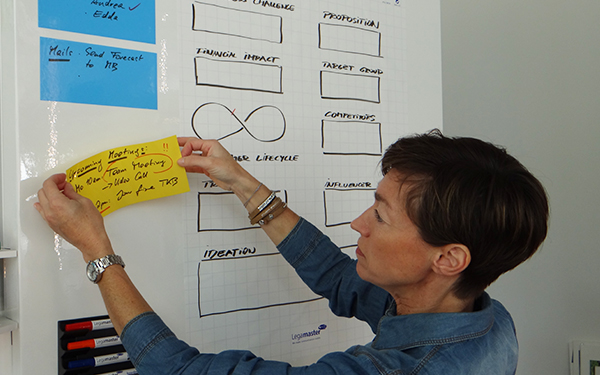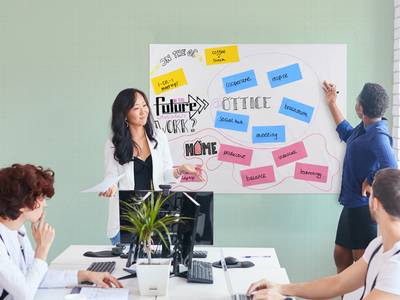
The last months made very clear to professionals around the world that ‘home office’ is rather an activity than a well-equipped space in their home. To discuss the home office concept and how they approached the development of their new HOME solution, which they call the Swiss army knife for home offices, we interviewed our friends from Playroom - René Massatti and Alexander Wolf.

René: "The three keywords would definitely be: future-oriented, user-oriented and agile. We work with companies to co-create innovation rooms like Agile Spaces or Innovation Labs based on clear objectives and KPI’s. We deliberately chose a playful approach to a serious matter. The average business environment is not very stimulating in terms of creativity and innovation. We all know intuitively how good ideas are created, but we have forgotten it. As children, we had our playrooms where we could develop ideas - sometimes alone, sometimes together with others. Today, we call this design sprints, prototyping and co-creation. Nothing new, we have only unlearned it and are usually not allowed to use it in a company context."
Alexander: "Form follows function - that's of course a very classic saying from product design. For us, it is the translation of what we do. We don't just design furniture. We come from the play side. We first ask 'what function should it fulfil?' and then it takes shape. We ask questions like, what kind of process is going on there? How do people move? What are they doing? From there, the needs are formulated. ‚Room follows play‘ also gives us guidance. Because in the end, you want to play and you don't want a nice room. The space is the means to an end."

René: "While a lot of work is taking place remotely now, people still want to meet and not just digitally. In my opinion, moving forward a lot of things will take place remotely that do not have to take place physically. I don't have to commute to a city every day and sit there for 8 hours and drive home again. But not everything will take place remotely."
Alexander: "Yes, exactly. Even though the current situation is economically challenging, it has also brought new insights and raised new questions. Can you also do home office? In many places it works and that generates new questions. How will we work in the future? And when many people are at home, how will that work? Or vice versa - will the face-to-face meetings perhaps also gain importance? If we meet, then we want to get the maximum out of it. This leads to more attention for the quality, the space and the process."
Alexander: "As a product designer, I look at new situations with open eyes. What is happening now and what is changing? And in this case, what happened was that I saw lots of Zoom and Skype meetings. Professionally and privately. And I saw that everyone is sitting in their home, which is now suddenly supposed to be their working environment while it's not made for that from the start. There's always some table with the laptop on it, but a lot of things are always pasted on the wall, door, mirror or window. And that's when we saw the need to organize things. The result is our Playroom HOME Edition."
René: "Also, I come from the field of trend research and I have constantly exchanged ideas with colleagues and read a lot of articles. And it was clear early on that the topic "Remote X" will remain. It will not be remote only, but we quickly agreed that we will work at home much more than before. That's not a topic that will go away as soon as COVID is gone. This will become a part of the new normality, that you can set up an office at home. We see a need to turn the home into an office. Not permanently, but only when you need it with maximum agility."
Alexander: "That was definitely an important point. That's why we have designed HOME so that it can be moved very quickly. It can also be completely disassembled. The important thing is that the structure is preserved and you don't put everything away in the evening. The structure remains and you can immediately continue the next day. And in our opinion, a wall works even better to visualise tasks or a planning than a table. That's why we turned the wall into a multifunctional tool. We have, so to speak, developed the Swiss Army knife of the home office."
René: "I can immediately answer that. I think I'm not the only one who can't sit after five zoom meetings. I can’t stand to sit and sit and sit and sit and sit in the same chair all the time. So, the possibility to work in different positions is really important for me. Also, during video calls, it bores me that everyone always has the same laptop and camera position. I think it's really good to get a different perspective on people."
Alexander: "One thing that is really simple but has a great impact is the overhead plug-in. While drawing, you can simply put your mobile phone on top and broadcast live what you are doing. It's easy - just put the phone down and we'll start. Of course I can also prepare a PDF and send it, but actually visualising it during our call, e.g. on Magic-Charts, makes it more lively. Then we can talk and work on the topic. It's all about communication and wanting to exchange ideas."
Alexander: "Really positive! We get a lot of feedback from different areas. We also get unexpected ideas regarding the application. We get for example enquiries where HOME is not something that a person buys, but a company for its employees. For example as first-aid kit in the office - ready to hand out at the start of the next crisis just like in the army - everyone takes their HOME with them and then they work."

Alexander: "We think it is here-to-stay. It is triggered by COVID, but in the most positive sense. Now we will see how it will develop. We have very clear feedback from the business world, where even companies that were initially completely against home office now say: "Yes, great - it works perfectly"."
René: "I definitely think that the remote theme will stay and that we have a product with HOME that could fit in. But we also know from experience that in 2-3 years the product will probably look completely different because things are always evolving based on user feedback. So, we don't know if the product will stay exactly the same, but the theme remains and the concept remains."
Alexander: "It will certainly be different. If the product still looks the same in 3 years, then we should stop. Then we have done something wrong. In a time, which moves so fast, it cannot remain the same. And that is exactly what we find refreshing."
